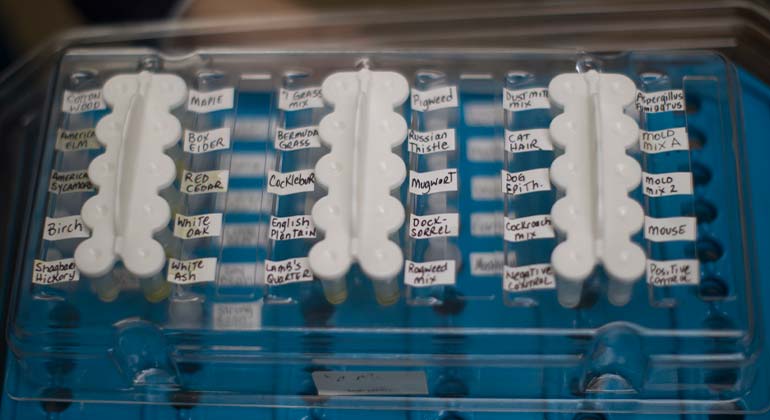Allergy Testing

If exposure to certain animals or foods make you sneeze, you may have an idea of your allergic trigger, but sometimes the triggers are not obvious. Our staff at Mount Sinai can help you pinpoint the cause of your allergic symptoms. Our allergists diagnose patients with these three steps: a personal medical history, a physical exam, and allergy tests to determine the source of your allergic reaction.
At the Mount Sinai Health System, our team of allergists and immunologists provides you with the tools to take control of your allergies, no matter how severe.
Skin, Patch, and Blood Tests
If you suspect that you are suffering from allergies, the best way to confirm your suspicion is to be tested by an allergist. An allergist will be able to identify your triggers with allergy tests.
A prick skin test is the most widely used type of allergy test. The test involves pricking the surface your skin, with a standardized allergen such as cat, dog, grass,etc. If your body has specific IgE to that allergen, you will develop a small hive at that site. Hives look like a small mosquito bites. The hives will disappear in less than one hour. Your allergist can apply a cream or provide you with an antihistamine after testing if required.
Blood testing is another way to determine if you have allergen-specific IgE. This test measures the level of IgE (if present) in your blood. The testing is simple and typically only involves a single needle prick. Immunoglobulin E (IgE) is the antibody produced by the immune system that causes allergic reactions. Small amounts of the antibody are found in the blood. A blood test measures and detects a reaction to a particular allergen. Blood testing is commonly used for patients who may be taking medications that can interfere with the results of a skin test; for patients with a skin ailment such as eczema or psoriasis; and in cases where a test may cause a strong reaction to a certain allergen.
The sample is sent to a lab for testing. The results may take days to receive. These tests, along with a person’s medical history, must be interpreted by an allergist for accurate diagnosis.
Patch Testing
Patch testing is another test used to determine if a particular substance or allergen is causing an allergic skin irritation known as contact dermatitis. In patch testing, allergens are applied to patches, which are then placed on your skin, typically the arm or back. Typically the substances that are tested include: medications, dyes, metals, fragrances, and more. You wear the patches for about 48 hours. You should avoid bathing and any activities that cause sweating while undergoing patch testing. The patches are removed at a follow-up appointment. Inflammation at the patch site may indicate an allergy.
Oral Food Challenges
An ingestion or oral food challenge is the most definitive test to prove that someone is not allergic to a food. It is a way to determine if someone can safely eat a food to which they had a concern of being allergic to. Determining whether a food challenge can be done safely must be first made by a physician after reviewing the history of reaction to the food and testing results (skin testing and/or blood). During the challenge, the patient eats increasing amounts of a particular food while under the supervision of an allergist. If reaction occurs during the challenge then that confirms a food allergy.